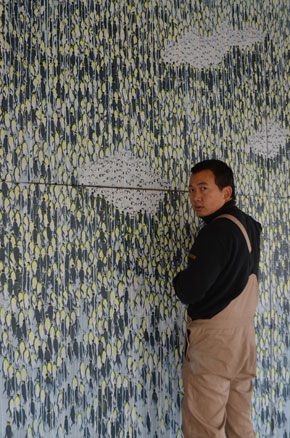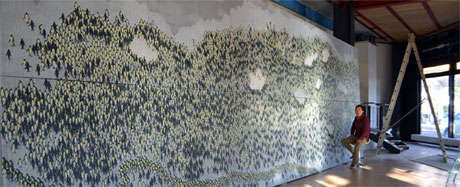in Mongolia of 22. December 2015
Өнөөдөр сонин
2015 оны арванхоёрдугаар сарын 22




„It is time we light candles to commemorate the many penguins which were slaughtered to make lamp oil.“
Newspaper Unuudur („Today“) in Mongolia of 22. December 2015



The Artist E. Otgonbayar, who is a resident of Germany, raised his voice against global climate change and brought back to life 20 000 penguins
with the stroke of his brush. He comments on his nine meter broad
and three meter tall painting: “Climate change causes the extinction of
plant and animal species on earth, as the first victims of human
misconduct. However, the existence of humanity is endangered as
well; together with the ice, it too, will melt away. It pains me
to see how nature suffers and my Antarctic-Panorama speaks of this pain.
I
have largely completed work on this picture, which I started in May
2015. I had informed myself about climate change rather
intensely, but never really intended to paint something like this. The
penguins caused me to paint this picture. Their story is so tragic that
it can only be depicted in black shades.
In the past two
hundred years the population of penguins have decimated dramatically.
Statistics tell us that there are only around forty colonies of emperor
penguins left worldwide, of which each counts around one hundred to one
thousand members. And so one day I came up with the idea to
create another colony of emperor penguins, the forty-first. It would be
comprised of 20 000 members.
Humanity has committed great sins
against penguins. At the beginning and mid-19th century seals, wales,
elephant seals and similar animals were hunted on great scale. The
massacres of these animals could almost be compared to the tragedies of
the first and second world war. Initially the penguins went unnoticed,
for their meat was considered inedible and their skin was too hard for
processing. Nevertheless, when man realized that their grease did not
congeal, much like that of the common lamp oil, they literally squeezed
the poor animals, or they were burned alive for fuel.
The heavy
loaded ships carrying thousands of slain seals, wales, etc. consumed
vast amounts of coal. Not only was this very expensive, but the
coal-fired ships were also much too slow. Firing the furnaces with
penguins, not only provided good fuel, but also saved coal. Officers
and sailors reported that they burned around 700 animals per day on
their ships. One of these reports reads: “The penguins cause a lot of
clamor anyway. Whenever we threw one of them into the fire alive, it
screamed miserably for about a quarter of an hour until it was dead.
Then we threw the next one into the furnace.“
It got even worse
when someone came up with the idea to use penguin grease as lamp oil.
The Macquarie-Islands mainly processed royal penguins. A royal penguin
could deliver 250g of grease. 4.000 animals delivered a ton of grease,
which was traded at eight-teen pounds sterling only. As one of the
reports reveals the poor animals were driven over a ramp screaming
miserably and fell into a cauldron of boiling oil. This is where they
were boiled alive. According to reports, this is how 4.000 to 6.000
penguins were used daily. The animals added up to around 150.000 per
season for a period of 70 years. Faced with these numbers we
realize the measure of human wrongdoing. Eventually, animal rights
activists put an end to these cruelties and the factory was closed in
1918.
This is the true history of penguins which were doomed
to light up our dark Europe –as living torches so to say. Like it or
not, these animals arouse compassion, one feels the need to help them,
do something for them. The Antarctic-Panorama was created out of this deep compassion. Today, I was invited to a conversation with the Ms. S. Oyuun,
a member of the Mongolian parliament. We will discuss how artists
can be heard in the struggle against climate change through their
medium of art. I still remember the day when I first read about the
fate of the penguins. I was captured by their story and when I suddenly
heard some kind of noise behind me I got terribly scared. It was then
when I realized that I was crying. I was haunted by nightmares for
three nights. It is really such a terribly sad story, the fate of the
penguins.”
Translation from German to English by Elisa Kohl-Garrity
 www.facebook.com/OTGOArtist
www.facebook.com/OTGOArtist
Newspaper Unuudur („Today“) in Mongolia of 22. December 2015
Өнөөдөр
сонин, 2015 оны арванхоёрдугаар сарын 22
http://mongolnews.mn/1rht
work
in progress:
Antarctic Panorama Penguins 300 cm x 900 cm
acryl on
canvas by OtGO
Gallery-Studio OtGO -2
Berlin
Antarctic Panorama Penguins 300 cm x 900 cm
acryl on
canvas by OtGO
Back